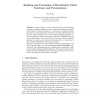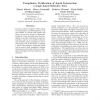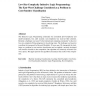367 search results - page 31 / 74 » Prolog |
SLP
1989
13 years 9 months ago
1989
This paper describes a learning system, LASSY1, which explores domains represented by Prolog databases, and use its acquired knowledge to increase the efficiency of a Prolog inter...
CORR
2008
Springer
13 years 8 months ago
2008
Springer
Prolog's ability to return multiple answers on backtracking provides an elegant mechanism to derive reversible encodings of combinatorial objects as Natural Numbers i.e. ranki...
AAI
2006
13 years 8 months ago
2006
In open societies of agents, where agents are autonomous and heterogeneous, it is not realistic to assume that agents will always act so as to comply to interaction protocols. Thu...
ENTCS
2008
13 years 8 months ago
2008
Logic meta-programming in Prolog is a powerful way to express program analysis and transformation. However, its use can be difficult and error-prone because it requires programmer...
CORR
2002
Springer
13 years 7 months ago
2002
Springer
The Inductive Logic Programming community has considered proof-complexity and model-complexity, but, until recently, size-complexity has received little attention. Recently a chal...



